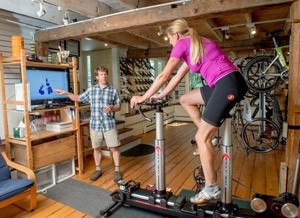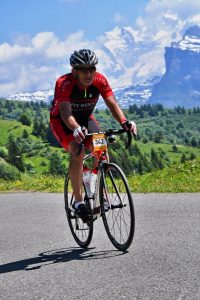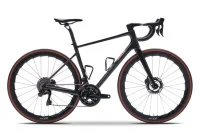Bike Fit for Indoor Training
When the seasons transition between riding indoor and outside are usually when we receive the most questions about fit related issues. And for good reason. While you may be on the same bike and same riding position, riding a bike indoors and riding a bike outdoors are different experiences. Also, many riders don’t maintain their technique and posture from outside riding to indoor riding. As we head towards winter, here are some things to keep in mind when it comes to your bike fit, riding position and technique when riding indoors.
What Positioning Changes are Recommended When Switching from Riding Outdoors to Indoors?
Ideally, if you have a good position and good posture/technique when riding outside, no positioning changes should be needed between indoor and outdoor riding. Same muscles, same balance,  similar results.
similar results.
This being said, some riders just can’t find comfort on the trainer and we make positioning and fit changes accordingly to do what we can to make the experience better. These changes may involve relaxing the position so that it is less demanding indoors. Sometimes we also recommend a saddle with different padding or shape for indoor riding or adding in aerobars to a road bike to provide another position for long sessions.
Regardless, the change from outdoor riding to trainer often offers a great opportunity for a review of your riding position and fit in general. It is also the most ideal time for many riders to revisit and refresh their focus on postural and musculature items that could benefit from work. Especially with athletes we have worked with before, well over 50% of the time in a fitting at Fit Werx can be spent on these critical technique and postural items. From our perspective, you can’t talk bike fit without also talking riding technique and posture!
What Comfort Issues are More Prevalent When Riding a Trainer Indoors?
The motion of a bike below you when riding outdoors can help mitigate a number of issues that can be highlighted when riding a bike that is stationary.
- Muscle Dominance or Imbalances. If you tend to be muscle dominant or imbalanced, or don’t have great pelvic stabilization, you will rock and/or twist on your saddle. The bike moves around beneath the rider enough that this may not cause notable issues riding outside, but may lead to problems ranging from pressure to saddle sores when the bike is no longer moving below you.
- Saddle Issues. See the last point and click here to see more articles on what causes most saddle issues (inside or outside).
- Shoulder/Neck. It is not uncommon to see people brace against the bike more when riding indoors than outside. It is easy to get into the “pain cave” mentality of just grinding away on the trainer without remembering that you are supposed to stabilize and support your upper body and pelvis with your abdominal muscles. Bracing with your shoulders can cause discomfort in the shoulders and a host of thoracic outlet issues…
- Numb Hands. Related to the last point, you stand a higher chance of numb hands for multiple reasons. Remember, the nerves that supply the hands pass through the thoracic outlet and originate in the cervical spine. If you brace, your hands will go numb and the bike not moving below you will make everything feel firmer and eliminate the cushioning of the tires.
- Single Sided Joint Issues. The static nature of riding indoors can exaggerate some muscular imbalances, which in turn can amplify joint loads and sometimes lead to pain.
This is by no means a complete list. Some riders experience more back pain on the trainer, others a greater chance of getting foot numbness, etc. The point is that riding indoors can bring items to light that are not noticed as much outside. Learning how to listen to what they are saying is the key.
What Technique Items Most Frequently Get Forgotten When Riding Indoors?
 Trainers provide a great opportunity to work on fundamental technique items. While the short answer to the question is that you want to work on all aspect of technique, making sure you work in digestible amounts at a given moment is often crucial to making true progress. Some of the bigger ones that many riders can benefit from include the following:
Trainers provide a great opportunity to work on fundamental technique items. While the short answer to the question is that you want to work on all aspect of technique, making sure you work in digestible amounts at a given moment is often crucial to making true progress. Some of the bigger ones that many riders can benefit from include the following:
- Find “Home Base”. Where are your contact points now and where are they supposed to be? We focus a lot of time on contact point recognition in our fittings today. Do you know what yours are?
- Core Support and Stabilization. Do you hunch when you ride? Do you hyperextend? Do you use your lower abdominals actively to allow you to relax the neck, shoulders and back? Target a neutral “Universal Athletic Position” (ball sport ready position) posture when riding.
- Cadence. Do you get bogged down when riding indoors? Make sure to get your cadence up and keep it up.
- Muscle Recruitment. Do you rely on one muscle group to pedal your bike or many? Do you use your glutes when you ride? You should…
- Knee Stabilization. Do your knees move around laterally a lot when you ride? While some knee motion can be due to foot mechanics, tight/worn hips or skeletal variances, often knee motion highlights a lack of muscle stabilization at the pelvic level at a given part of the stroke. Strengthen and use the lower abs and glutes to keep your pelvic angle balanced and neutral and then add in your inner thigh to completely rid yourself of knee motion.
- Keep Your Feet Straight. While not everyone can or should do this, most people should target keeping their feet straight while pedaling. Don’t let your heels come way in or way out. Heels that rotate inward often indicate the rider is unlikely to be accessing their glutes actively.
- Increase Power. Related to maintaining a relatively high cadence, riding on the trainer provides an excellent opportunity to do controlled intervals and power builds that can help you increase your overall power. Especially if you are a distance specialist (do you IM?), this can be a really important piece to taking that next step in speed.
When is the Best Time of Year to Make Fit Changes?
Likewise, if you are thinking that positioning related changes make sense on your bike, doing those heading into indoor training time can be the best time of year. For many, this means the fall and winter. Why make changes in the early part of the off-season?
- Concerns and issues from outdoor riding season are often top of mind and clear.
- Riding an indoor trainer takes the concentration you need to spend on traffic, road hazards and motion out of the equation. This frees up brain space for honing your muscle recruitment, contact points and balance.
- Habits are established by repetition. Trainers do a good job with repetition.
- Breaking into a new position slowly is always a good idea. The trainer allows for this without the pressure of “keeping up with the group” or finding yourself on a longer than intended ride on a colder than expected evening using new muscles that are getting tight.
- Putting the time on the indoor trainer pays off when you start riding outdoors again. It allows you to be ready for the season and makes those early season outside riders easier and better.
- In a nutshell, there is usually less pressure in the fall/winter. Less pressure to perform at a certain level; less pressure to get your equipment ready for a ride or race that is coming up; less pressure to go too hard too early and pull a muscle… You get the idea.
If you are finding the trainer uncomfortable or just think a fresh fitting would help in the next year, there is no better time than the present to get the most out your trainer time while helping you start the outside riding season as strong and comfortably as possible.
Contact us for more information or to schedule a fitting.









